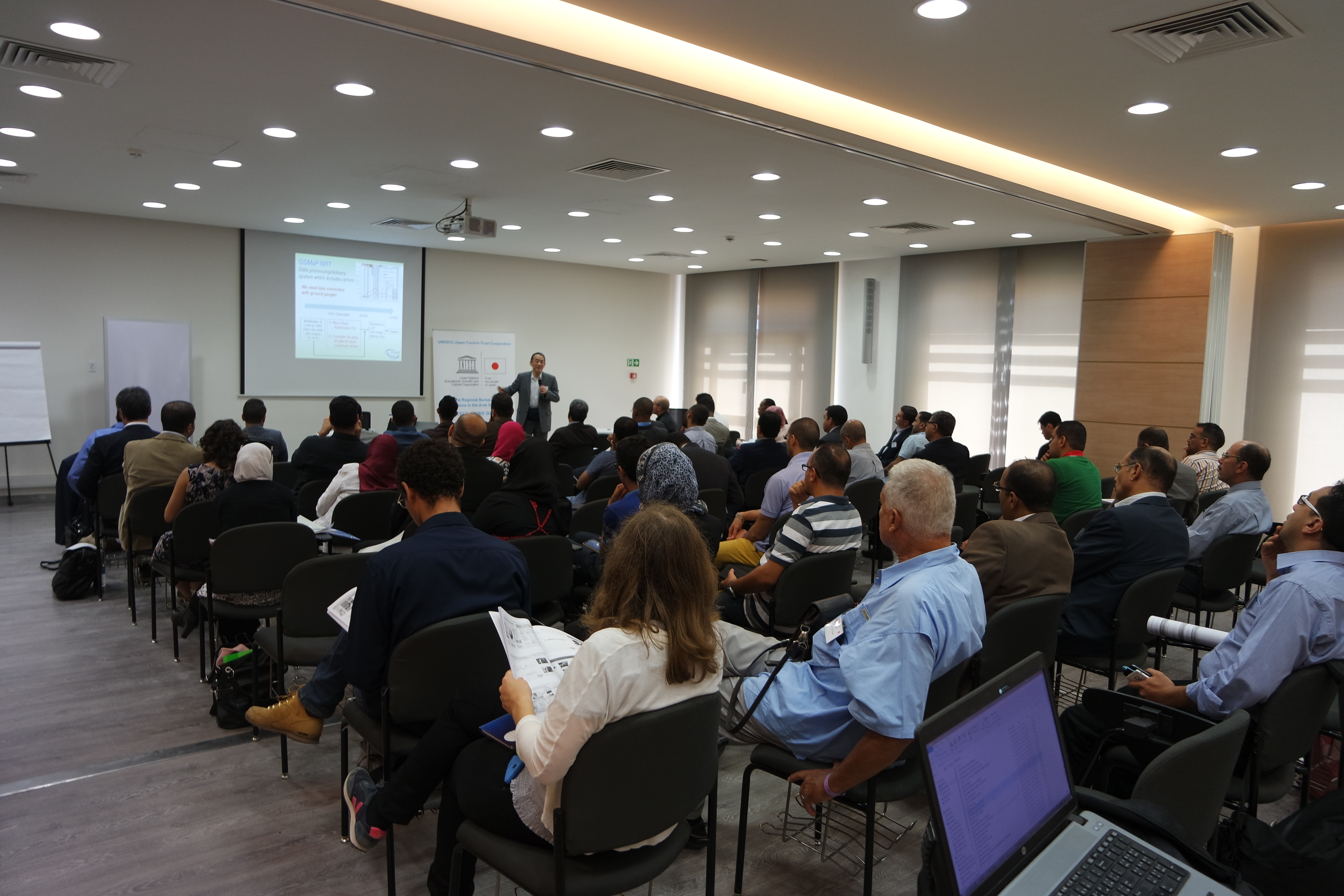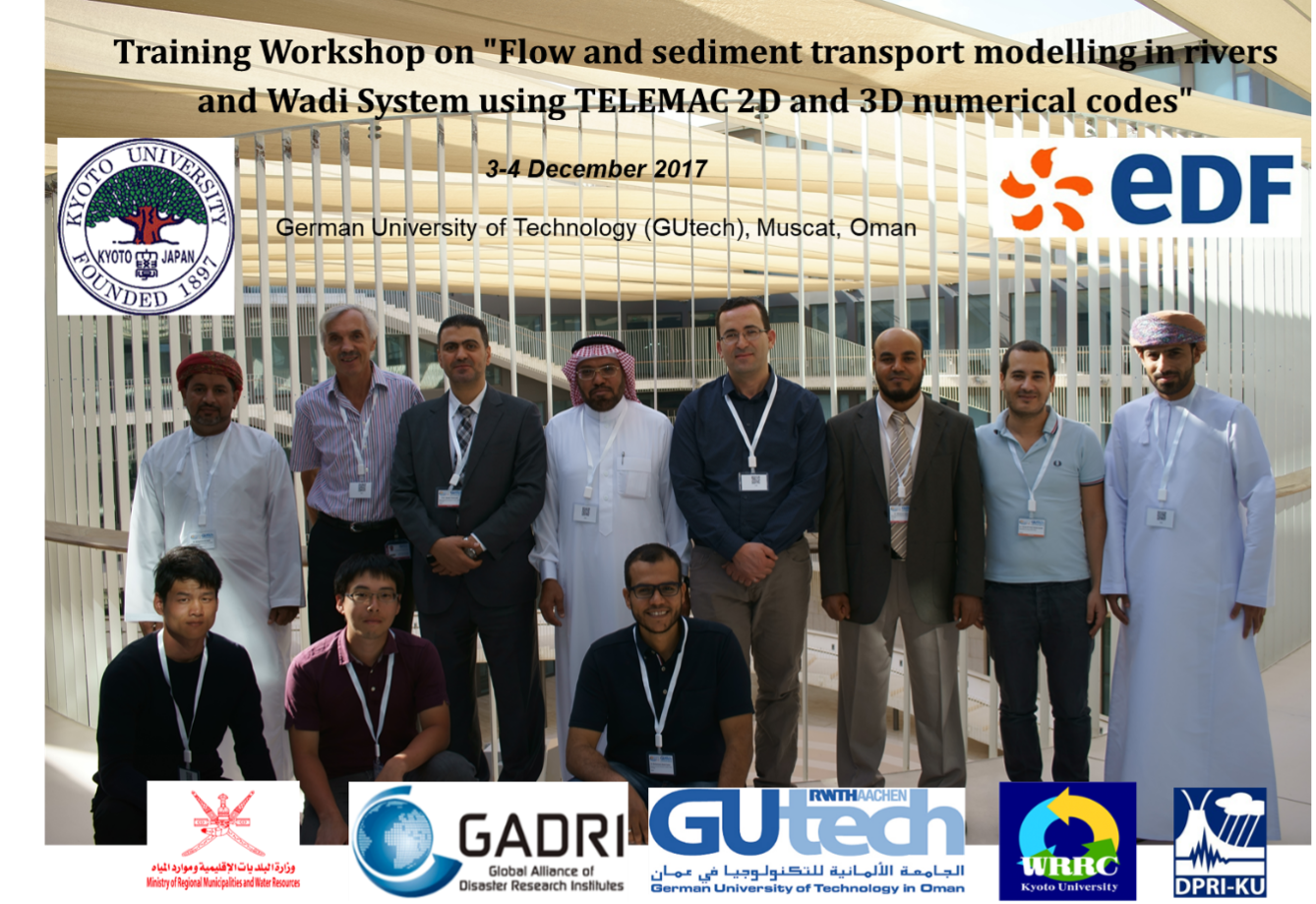News and Events
Additional training details will be added.
Trainings
- UNESCO training Workshop as additional event prior to the 2nd ISFF symposium, 2016, in Egypt.
- Training Workshop on "Flow and sediment transport modelling in rivers and Wadi System using TELEMAC 2D and 3D numerical codes"

Background and Objectives
Worldwide, flash floods have become a common experience, causing heavy economic damage and loss of human lives. These costs are likely to be exacerbated owing to the effects of population growth, climate change, increased urbanization, and to limited sewerage infrastructures and storage zones.
Wadi flash floods are short-lived, extreme events that occur when rainfall-runoff water leaves the Wadi channel and spreads across the basin. Flash flood forecasting is the first step to construct efficient warning and mitigate floods. There are several hydrological/hydraulic models developed to predict rainfall-runoff processes and simulate flood routing through a Wadi network. Rainfall-runoff modeling in Wadi systems is a complicated and challenging problem since we have to consider various interconnected variables and processes (e.g. surface - subsurface flow interactions, appearance of wet and dry areas). The need to obtain accurate and detailed information on flash flood hazards is now recognized. To cater for this demand, reliable numerical tools are needed. Numerical models do not only offer the potential to characterize flooding in wadi areas and to map flood hazards, but also help to design mitigating measures and support effective land use and emergency planning. In the same time, significant efforts have been made to use remotely sensed data (e.g. classified aerial imagery, Light Detection and Ranging (LiDAR) terrain measurements) capable of providing high-resolution Digital Model Terrain (DTM) in 2D or even in 3D space, guiding therefore mesh generation and model parameterization.
This two-days training workshop provides an overview of the capabilities, limitations, and challenges in hydraulic modelling of flow and sediment transport in rivers and Wadi systems. The German University of Technology in Muscat is organizing this workshop training course in collaboration with Kyoto University on 4-5 December 2017. Details of the training course and other relevant information are given hereafter.
CONTENTS
TELEMAC is an integrated suite of solvers for use in the field of free-surface flow, waves, water quality and sediment transport. In particular TELEMAC simulates flow propagation at the catchment scale and was successfully applied to the case of King Valley in Egypt, among other examples. Using the remote sensing DEM enables to generate the mesh over the case study area. The roughness can be spatially distributed to describe the heterogeneity of the soil composition and cover.
Having been used in the context of many studies throughout the world, TELEMAC has become a major standard in its field. TELEMAC was made “open source” in 2010 to be freely available to the whole community of consultants, universities and researchers while being actively supported and continuously developed by a consortium of industrials, consultants and research organisations. Anyone can therefore take advantage of TELEMAC and assess its performance. For more information about TELEMAC-MASCARET see
This course covers a broad range of modeling techniques for fluvial processes using the TELEMAC suite of computer models. Lectures will provide both theoretical background and practical aspects of modeling flow and sediment transport processes. Introductory topics, which can be grasped by students without a background in numerical methods, will be followed by advanced topics such as mesh generation/optimization, selection of numerical schemes, flow and sediment interactions.
The capabilities and benefits of the TELEMAC modeling system will be shown by hands on application using data sets acquired on real rivers and Wadis.
LEARNING OUTCOMES
After completion of the short course, the students are expected to:
- Generate a computational mesh from a topographic data set using the free pre-processing software Bleu Kenue (www.nrc-cnrc.gc.ca/eng/solutions/advisory/blue_kenue_index.html
- Be able to create input files to execute Telemac2D and Telemac3D.
- Assess the impact of imposed flow on near- and far-field Wadi and river hydrodynamics.
- Assess the impact of imposed flow and/or sediment supply conditions on near- and far-field Wadi and river morphodynamics.
- 5. Be able to analyse and visualize TELEMAC output files using third party charting and data analysis software (for example Blue Kenue or Fudaa-Prepro (free software)).
PRE-REQUISITE
The course is suitable for participants wanting an introduction to numerical modeling of flow and sediment transport in rivers and Wadi systems. Participants should have basic knowledge on hydrological/hydraulic modelling, rainfall-runoff analysis, Wadi Catchment, open channel flow, sediment transport mechanics.
LANGUAGE OF INSTRUCTION
All course materials will be offered in English.
INSTRUCTORS
Instructors from EDF (France) and Kyoto University (Japan) are delivering the training lectures:
- Dr. Eng. Riadh Ata, EDF R&D- National Laboratory for Hydraulics and Environment, Chatou, France
- Dr. Eng. Kamal El kadi Abderrezzak, EDF R&D- National Laboratory for Hydraulics and Environment, Chatou, France
- Ass. Prof. Sameh Kantoush, Water Resources Research Center (WRRC), Disaster Prevention Research Institute (DPRI), Kyoto University, Japan
- Eng. Ogiso, Water Resources Research Center (WRRC), Disaster Prevention Research Institute (DPRI), Kyoto University, Japan
Training Workshop Agenda
Monday, December 4th 2017 at German University of Technology, Muscat, Oman 8:00-09:00 Registration
| Time | Title of Presentation | Instructors |
|---|---|---|
| 09:00-09:05 | Opening Remarks and Guest Welcome | Ekkehard Holzbecher (German University of Technology, Oman) |
| 09:05-09:20 | Welcome Speech by Kyoto University and Objectives of the Training Workshop | Sameh Kantoush (DPRI, Kyoto University, Japan) |
| 09:20 – 09:30 | Group Photo | |
| 09:30 – 09:45 | Coffee Break | |
| Module 1: General Introduction and Hydrodynamics | ||
| 09:45 – 10:45 | Introduction of the suite of numerical codes TELEMAC: General presentation, governing equations mathematical properties, numerical aspects | R. Ata (EDF) |
| 10:45 – 11:30 | Steering of TELEMAC-2D and 3D: description of input/output files, selection of user-defined parameters, parameters to be calibrated. | K. El kadi (EDF) |
| 11:30 – 11:45 | Coffee Break | |
| 11:45 – 12:45 | Use of Blue Kenue for the generation of geometry and boundary condition files | R. Ata (EDF) |
| 12:45 – 14:00 | Lunch Break | |
| 14:00 – 15:30 | Use of Blue Kenue on a field case | R. Ata & K. El kadi (EDF) |
| 15:30 – 15:45 | Coffee Break | |
| 15:45 – 16:15 | Run of TELEMAC-2D and 3D | R. Ata & K. El kadi (EDF) |
| 16:15 – 16:45 | Use of Fudaa-Prepro for post-processing of results | K. El kadi (EDF) |
| 16:45 – 17:15 | Use of Blue Kenue for post-processing of results | R. Ata (EDF) |
Tuesday, December 5th 2017 at German University of Technology, Muscat, Oman
| Time | Title of Presentation | Instructors |
|---|---|---|
| 09:00 – 10:00 | Some advanced features: programming of user subroutines, parallelism | R. Ata (EDF) |
| 10:00 – 10:15 | Coffee Break | |
| 10:15-11:30 | Use of Blue Kenue for Wadi system (at the scale of the catchment) | R. Ata & K. El kadi (EDF) |
| 11:30 – 12:00 | Run of TELEMAC-2D and 3D for a wadi case (Wadi Aday in Oman or another case) | R. Ata & K. El kadi (EDF) |
| 12:00-13:00 | Lunch break | |
| 13:00 – 14:00 | Post-processing of results | R. Ata & K. El kadi (EDF) |
| 14:00 – 14:15 | Coffee Break | |
| 14:15 – 15:00 | Introduction to the morphodynamic module Sisyphe of Telemac | K. El kadi (EDF) |
| 15:00 – 16:00 | Steering of Sisyphe: description of input/output files, selection of user-defined parameters, parameters to be calibrated. | K. El kadi (EDF) |
| 16:00 – 16:15 | Coffee Break | |
| 16:15-17:00 | Run of TELEMAC-2D coupled with Sisyphe on a river case and post-processing of results | R. Ata & K. El kadi (EDF) |
| Open Discussions: Future Development and Feedback | ||
| 17:00 – 17:15 | Summarizing: How to build your numerical model? | R. Ata (EDF) |
| 17:15 – 18:00 | Discussion | All |
